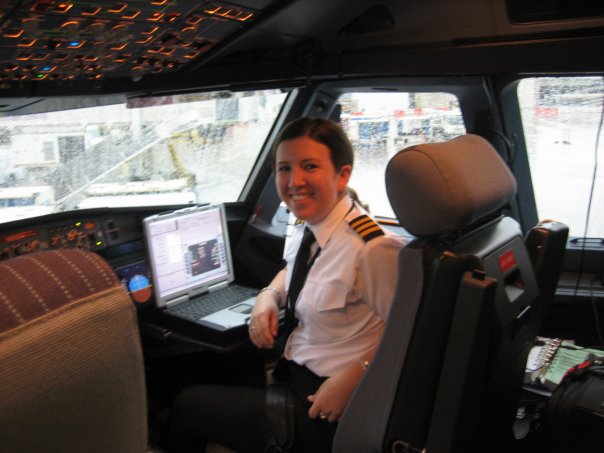As the time I've written this we don't know the fate of Air France flight 447. I pray that the passengers and crew found a miracle and are safe somewhere.
In the usual pattern of 24 hour new networks, I'm spending my morning yelling at the TV while some of their "aviation experts" speculate on the fate of an airplane they know nothing about. I don't know enough details to speculate myself (turbulence? lightning? electrical failure? There are too many possible causes) but I will give my piece on how a fly-by-wire airplane is controlled, and specifically an Airbus system.
Disclaimer: I hold an A320 type rating. There are differences between A320 systems and A330 systems, and I'm not as knowledgeable about the latter. So if I make an assumption about A330 systems that is incorrect, please forgive me. And feel free to comment/correct.
Fly-By-Wire
Fly-by-wire is a term used to explain how the control surfaces of an airplane are moved (control surfaces mean the ailerons, rudder and elevators, the movable pieces of the airplane that are used to control it).
The first method of moving control surfaces was by cable. When the pilot moves the yoke or stick and the rudder pedals, this directly manipulates cables that displace the control surfaces. This is still used effectively on smaller airplanes such as a Cessna 172.
The bigger an airplane gets, the larger the control surfaces must be, and the more force must be exerted by pilots to move them. So hydraulic controls became popular. The amount of force on the cables is amplified by hydraulic actuators that move the control surfaces. This is the most-utilized method used in airliners today.
Fly-by-wire airplanes operate differently. Any deflection of the yoke/stick/rudder pedals by the pilots is detected by computer sensors. The sensors determine the amount of deflection, or movement, needed in the control surfaces (using data such as airplane altitude and airspeed) and send this information to hydraulic actuators which then move the ailerons, elevators and rudder.
The major difference between cable-controlled airplanes and fly-by-wire airplanes is the use of, and dependence on, computers to control the airplane's movement.
Now onto the A320...
The A320 has 7 flight control computers:
2 ELACs: Elevator Aileron Computer (normal elevator and horizontal stabilizer control, as well as aileron control)
3 SECs: Spoilers Elevator Computer (spoiler control as well as standby elevator and stabilizer control)
2 FACs: Flight Augmentation Computer (electrical rudder control)
So you see that there are multiple levels of control for most of the control surfaces. If one set of computers was to fail you'd still have some control over the airplane.
I'm going to quickly go over the "levels of control" with the A320. Airbus calls these "laws." I'm glossing over certain points to keep this entry from becoming a novella.
In normal flight the computers are in "normal law." In normal law the pilots use the control stick to move the airplane. The airplane's computers actually prevent the airplane from stalling/overspeeding or undergoing any other maneuvers that may cause excessive stress on the airframe.
If computers start to fail on the airplane, it reverts into "alternate law." In alternate law you can still have some of the protections (i.e. stall protection) that you had in normal law.
Direct law is the next lowest level of control. I skipped over how the A320 is controlled by load factor demand and bank angle. So I'll just say that in direct law you control the A320 just like how'd you control any other airplane with a stick. Pull back and the nose will start to rise, move the stick left and the airplane will start to roll left.
Below direct law is "manual backup." If you were to lose all electrical power in the A320 your only hope of controlling the airplane is mechanical backup. This, I believe, has only happened once outside of testing. You would have to lose both engine generators, the APU (auxiliary power unit, another generator), drain your batteries and be unable to operate the RAT (ram air turbine, which is deployed from the bottom of the airplane and can provide limited power).
Pitch control is only available to the pilots through use of pitch trim, using the horizontal stabilizer of the A320 (it's called the THS, trimmable horizontal stabilizer).
Lateral control is only possible through use of the rudder pedals, which do have some direct linkage to the rudder.
When undergoing simulator training for the A320 type rating I had to try to fly the airplane using mechanic backup. It is NOT easy. It was nearly impossible to maintain level flight. Mechanical backup's purpose is to provide the pilots a way to keep the airplane stable while they troubleshoot the failed electrical system and flight control computers. I can't imagine anyone trying to land the airplane using mechanical backup. You simply don't have enough fine control.
Once again, this was all referenced from my A320 training and my A320 manuals. I don't know enough about the A330 to say whether all (or any) of this applies to the A330, but I'm going on the assumption that Airbus wouldn't have totally redesigned their fly-by-wire system for another airplane.
Subscribe to:
Post Comments (Atom)

1 comment:
Thanks for this info.
I'm sort of curious; have any larger planes used cables to actuate the flight surfaces and used aerodynamic trim tabs to dynamically reduce the control forces? So that as you say, pull the yoke, the trim tab moves a bit as well to reduce the forces required?
Post a Comment